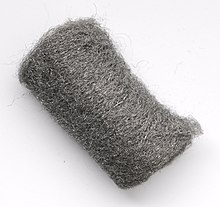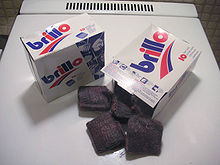Steel wool
As steel wool is referred crimped steel fibers formed by the special " scraping effect " of the metal fibers for cleaning, grinding and polishing can be used.
Manufacturing
The starting material for steel wool is a steel wire made from a special alloy. This is delivered on rolls ( coils ), drawn by special machines with fluted knives and cut into fine fibers. Depending on the knife corrugation , the cutting angle of the knife and the machine speed, finer or coarser fibers can be produced.
These steel wool machines can produce several degrees of fineness at the same time and produce wide steel wool ribbons made from thousands of metal fibers.
Properties and qualities
Commercial steel wool consists of a thick band of sharp-edged fine metal fibers. These fibers ideally have a 3 or 4-cornered cross-section, so that the desired “ scraper effect ” is created when the steel wool fibers are used at right angles to the direction of sanding. Steel wool is very tear-resistant and elastic. It is therefore often used for processing grained wood surfaces , as the steel fibers reinforce the surface geometry and do not grind flat like e.g. B. sandpaper and abrasive fleece . Wood grains are emphasized even more.
Steel wool is classified according to degrees of fineness, in Germany usually as grades No. 0000, 000, 00, 0, 1, 2, 3, 4, 5. The finest fibers have No. 0000 on this scale, the coarsest No. 5.
Steel shavings are even coarser than steel wool, and their degrees of fineness are: Fine, Fine, Medium, Coarse, and Ultra Coarse. Steel filings are also more curled than steel wool and not quite as elastic.
This classification applies internationally, but the actual degrees of fineness of steel wool can vary greatly from country to country.
When used dry, steel wool has an almost unlimited shelf life. It can rust if exposed to water or aggressive chemicals . On the other hand, stainless steel wool , which is used particularly in damp areas, is rustproof.
application
Steel wool is used to process a wide variety of surfaces such as wood, metal, plastic, stone and glass, and also for matt sanding of polished and lacquered surfaces.
The surface effect of the steel wool is extremely gentle, as it results from the "scraper effect" and not from the hardness of the steel.
Cleaning pads and disks
For commercial and household use, cleaning pads or special cleaning discs and rings made of steel wool are available for mechanical use on wooden and stone floors. These products, especially the cleaning pillows for the household, are often mixed with soaps and polishing red and are used, for example, in the kitchen to clean pots and pans with burnt-in food residues, tiles , tiles and glass ceramic stoves . In addition to steel, aluminum wool is also used for cleaning purposes.
In the USA, a steel wool pillow with soap was first patented in 1913 under the brand name Brillo . It is still marketed under this name in North America today. Well-known brands in Germany include abrazo and Ako-Pads.
From 1917 onwards, the sales representative Irwin W. Cox added soap and steel wool pillows to pots as a sales addition. Since the demand for this steel wool was higher than for pots, he began to concentrate on the manufacture of the pot cleaners. These cleaners are still manufactured today by the Clorox company.
Others
With steel wool it is also possible to prove that iron - in the presence of oxygen - can burn. The fibers of the wool glow visibly when you hold them over a hot flame , e.g. B. a Bunsen burner , or with a charged battery in contact. For example, steel wool can be used to start fires outdoors.
When it comes to disposal, steel wool is environmentally friendly. The steel fibers naturally rot through rusting. Some gardeners also work steel wool into their beds to improve the iron content of the soil.


